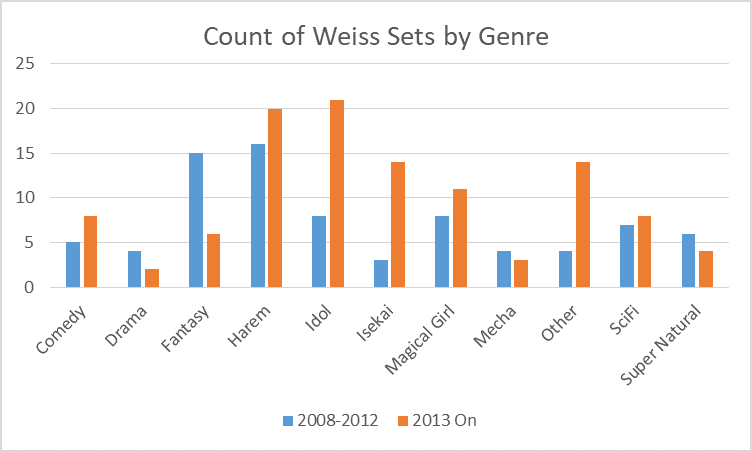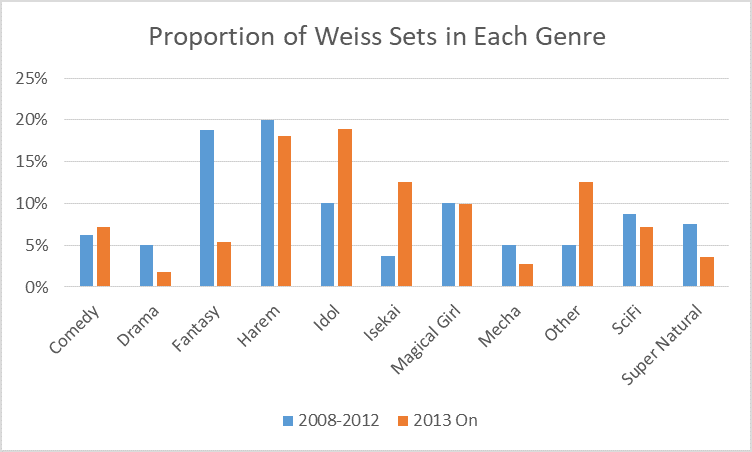Last year, 2018, was the tenth anniversary of Weiss in Japan. Over the years, Weiss has pulled from a wide variety of sets. Early on, the Fate series and Key visual novels were featured heavily. Over the years, sets from a large variety of shows began to emerge. Who could have expected sets from Crayon Shin-chan or Kemono Friends? Recently, players have started to note that Weiss Schwarz may as well be called Idol Schwarz.
Today, I seek to see if this idea has merit statistically. Has the genres of sets that Bushiroad released changed significantly over the last five years compared to the first? I conduct this analysis by considering booster sets and extra sets that add at least 20 new cards[1].
TL;DR
Weiss can now be called Idol Schwarz.
Sets at a glance
To be more specific about what analysis we are conducting here, we want to see if the distribution of Weiss sets from 2008-2013 has changed from the distribution of sets introduced from 2014 to 2018. A detailed list of all Weiss products released is available over at Heart of the Cards. I have omitted 2019 since the year is not over. Overall, there have been 191 sets that meet the pre-stated criteria of being a booster type set that add at least 20 cards. There were 80 in the first 5 years of the game, and 111 up until the end of 2018. I coded the genre and overarching series to each set. Anime show genre was retrieved from MyAnimeList, VN genre was retrieved from VNDB and a comparable video game genre was retrieved from Wikipedia. Items that had three entries or less in the 2008 to 2013 period were binned as other. Slice of Life shows were classed as comedy.
In the early years, Weiss pulled from two main genres: Harem and Fantasy. 13 of the 21 sets from the first two years of the game came from these genres. Weiss pulled heavily from Key games, Da Capo (there is almost one Da Capo set every year), Persona, and Fate. As time rolled on, we saw some variation in the sets that released. We got our first idolM@ster sets, sets from Mecha and sci-fi anime, and Nanoha brought the first magical girl show. However, up until 2012, the main set drivers continued to be Fantasy and Harem sources. One in five sets were from a harem, and another one in five were from fantasy sources.

This greatly changes around 2012 and 2013. Two major source materials emerge; Symphogear and Love Live! Up until this point, counting Macross Frontier as a mecha show, the only idol show with any sets was idolM@ster. Idol sets exploded. Add in Bang Dream! and idol sets really took over what was being printed. One in five sets printed were idol sets between 2013 and 2018. Isekai, shows like Sword Art Online and KonoSuba, also became far more popular to release. Nearly 15% of all sets were from Isekai shows. Pretty much all the new sets that have some sort of fantasy setting in Weiss are Isekai fantasy. The switch from a more general fantasy to Isekai mirrors changes in the industry at large. Harem, however has continued to plod along, thanks to that annual Da Capo set and Key Visual Novels like ReWrite and Summer Pockets.
Methodology
To see if the distribution of Weiss sets has changed, we have to compare what came out between 2013 and 2018 to a counterfactual world where the releases were identical in proportion to what they were from 2008 to 2012. This is known as a Chi-Squared Goodness of Fit test. Basically, we are seeing if the differences between the orange and blue bars are statistically significant.

Formally speaking, the counterfactual is our null hypothesis. The counterfactual is constructed by multiplying the proportions from each bin in the 2008-2012 sample by the total amount of the sets from 2013-2018. We want to know if the realized releases and the counterfactual are from different distributions.

Note that the alternative hypothesis does not say why the distributions are different, just that they are. Our vignette at the earlier covers the reason why. We want to test if the differences between the actually released set counts and the counterfactual set counts are significantly different from zero. If we measure raw differences within each bin, we could use a t-test based distribution, but that would require way more observations, as a valid t-test requires at least 30 observations to approximate normality. However, we know that the sum of squared normally distributed variables are distributed chi-squared, and normed squared differences are usually normal[2] [3]. Formally:

Having a variable with a known probability distribution allows us to test how likely a result is. If a result we obtain is extremely unlikely, or if 1% or less of all outcomes are more extreme than this outcome is, we consider the null rejected and accept the alternative. Otherwise, we fail to reject the null. We can restate our hypothesis and solve:


Results
We have strong evidence to reject the null hypothesis that the genre of sets being released now is the same as they were in the first five years of the game. This is likely due to the emergence of “Idol Schwarz.” However, this was helped along by the emergence of Isekai. If you like harem VNs, you’re in luck! They’re still widely available to play in Weiss.
Data
available upon request
[1] This omits Trial decks, Trial Deck+, small promo sets, and power up sets. Including these accentuates the result, mostly because of Bang Dream’s a-zillion TD+ and iM@s power-ups and promos.
[2] Normally, we would test for normality at this stage, but this is for funsies, so we will just assume normality here.
[3] This method also relies on simple random sampling, however, our split is temporal. This is unlikely to be randomly sampled. The next step is to bootstrap from both distributions and compare using a goodness of fit test.
[4] The very extreme result seen here are likely due to the limited sample and the above caveats.

2 thoughts on “Weiss by the numbers: Has the genre of source material Weiss Schwarz drawn from changed?”